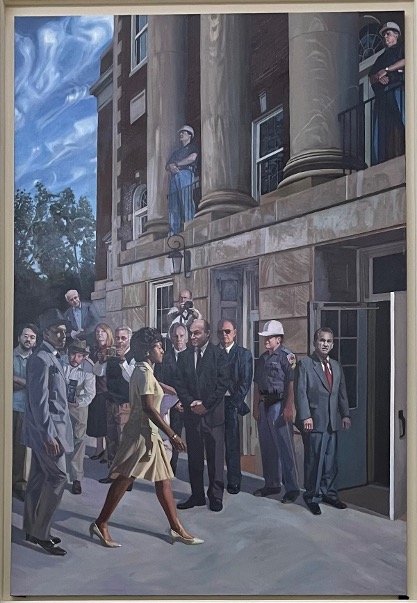by Trevor Linn, who just lately graduated together with his MA in Faith in Tradition from the College of Alabama.


The 2 photos above are of the identical day and occasion, every simply hours aside from the opposite. What’s the significance? The colour portray, titled Features of Change, now hangs within the Tuscaloosa federal constructing with new College of Alabama scholar, Vivina Malone, strutting previous the gang into the college to register for sophistication as if she was strolling the crimson carpet at a film premiere. The black and white image of Alabama Governor, George Wallace, blocking the door and being requested to maneuver by the Deputy Legal professional Basic of america, just isn’t hung in a federal constructing however lives in a group donated to the Library of Congress (obtainable on Wikimedia Commons). However it’s no accident that one is now a 14 ft. portray that individuals see each day, whereas the opposite lives as code. Caleb O’Connor, the artist contracted to do the portray, had an obvious aim with Features of Change, a aim that I see goes alongside effectively with the well-known College of Alabama assertion, “The place Legends Are Made.”
In 1954, Brown v. Board of Training was handed by the Supreme Courtroom to combine faculties throughout the nation. Nonetheless, the Governor of Alabama, George Wallace, had different concepts. He primarily based his marketing campaign for governor on a platform that may maintain Alabama faculties segregated. The primary photograph above depicts the final stand that Governor Wallace takes on the doorways of the College of Alabama to maintain faculties segregated. As increasingly more faculties started to combine, Wallace needed to make sure the nice establishment of the College of Alabama saved its all white standing. In his 1963 inauguration speech he mentioned “Within the title of the best folks that have ever trod this earth, I draw the road within the mud and toss the gauntlet earlier than the ft of tyranny…and I say…segregation in the present day…segregation tomorrow…segregation without end” (Blackpast). This custom although was already eroding, as there have been already two black college students, Vivian Malone and James Hood (the 2 figures within the work foreground), who had been accepted to the college. The story then goes that Wallace stood in entrance of the door blocking the 2 Black college students from getting into to register for lessons till Wallace was forcibly faraway from the doorway by the Alabama Nationwide Guard (Griesbach). Wallace’s image exhibits the custom that he and his supporters felt must be saved for the College of Alabama, however Features of Change tells a extra inspirational story of integration and acceptance.
Features of Change evokes one of many College of Alabama’s primary tag strains, “The place Legends Are Made” and collectively helps us see the position of custom throughout the portray and College. Russell McCutcheon and Aaron Hughes level out in Faith and 50 Extra Phrases, that once we take into consideration historical past and custom we should look to the current and the social actors concerned in claims and acts of custom” (281). Features of Change exhibits us three historic figures, Vivian Malone, James Hood, and George Wallace however is clearly making a press release about who’re an important figures, and thus what’s the applicable ideology. Governor Wallace, alongside together with his want for a segregated College, is clearly not the middle of the portray, and thus not the central narrative and thought. Vivian, in her shiny yellow gown and footwear, with the solar glowing on her and James’s face as they stroll to the doorways, takes heart stage. It’s them, and the historical past and custom they symbolize, integration and acceptance, that O’Connor has chosen to be the message of the portray. Thus, when considered when it comes to “The place Legends Are Made,” O’Connor, on behalf of the Metropolis of Tuscaloosa and the College of Alabama, is clearly making a press release about who the legends of Alabama historical past should be. By specializing in this second of College of Alabama historical past, O’Connor exhibits the continued creation of the College’s custom of excellence that it creates for itself and applies that custom to a curated second of the previous. Features of Change, then, not solely helps us see the development of “The place Legends Are Made” but in addition memorializes the folks that these in energy who commissioned the portray needed to see as Legends Being Made.
Picture credit: Picture of Wallace blocking the door by Warren Okay. Leffler, U.S. Information & World Report Journal, donated to the US Library of Congress, Public Area.
Picture of Features of Change, a portray hanging within the Federal Courthouse, Tuscaloosa, Alabama












